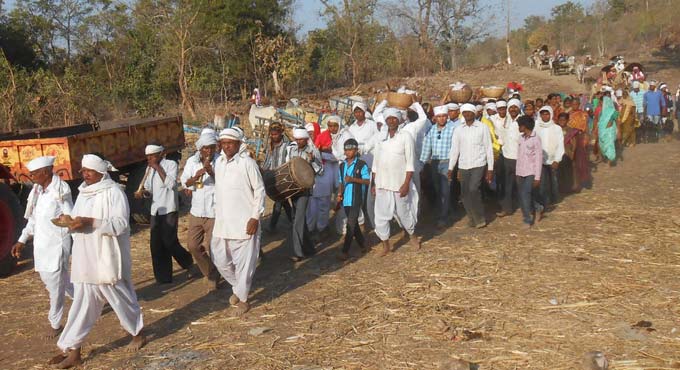Kumram Bheem Asifabad: The annual month-long Jangu Bai Jatara, an important religious and cultural festival of Raj Gonds and Kolams, began on January 16 at the cave temple of the deity in Sahyadri hills in the forests of Maharajguda hamlet under Kotaparandoli village in Kerameri mandal. The tempo of this Adivasi festival is expected to gain momentum in the next couple of days.
The fair kick-started with tribals performing ‘Devve Niruswal’ or lighting of the lamp which represents the deity at the temple in a low key affair following the Covid-19 pandemic on January 16. Huge gathering of Raj Gonds and Kolams are, however, expected in a couple of days, members of the jatara’s organising committee said.
Members of Raj Gond, Kolam and other tribes from several parts of erstwhile Adilabad district, neighboring Maharashtra and Madhya Pradesh have already begun arriving at the holy spot, trekking hundreds of miles and by bullock carts to worship the deity. Scores of aboriginal tribals dwelling in Indervelli mandal also set out by foot on Friday to take part in the fair.
25,000 year old temple
The ethnic tribes ceremoniously worship the deity Jangu Bai, that is believed to have been formed naturally 25,000 years ago according to Adivasi belief. They congregate at the temple during the sacred Hindu month of Pushya and take a holy dip in a tank locally known as Toplakasa before entering the temple. They perform traditional prayers and certain rituals as part of the fair.
A major proportion of devout reach the temple carrying bamboo baskets on their heads, beating drums and playing traditional instruments such as Sannayi, Kaliko and Tudum. The basket contains ingredients required for performing the prayers. The ingredients include rice milled through traditional methods, wheat, jaggery and oil extracted from either sesame or castor seeds.
Holy dip in Toplakasa
The Gonds throng the shrine after taking a dip in Toplakasa and visiting religious structures situated on the way to the historic cave temple. They then prepare a special Naivedyam to be offered to the deity and present it to her by performing deepotsavam. Later, they sacrifice hens and sheep to goddesses Maisamma, Pochamma and Ravudk.
The devotees conduct mass dining after taking darshan of the deity and participating in the prayers. They dance to drum beats and sounds of musical instruments and as per the custom. They meet priests after the rituals. The hilly premises of the shrine would become alive with the arrival of the hundreds of the tribals and the religious affair and cultural events.
Now you can get handpicked stories from Telangana Today on Telegram everyday. Click the link to subscribe.
Click to follow Telangana Today Facebook page and Twitter .
